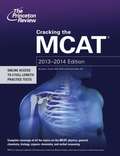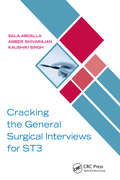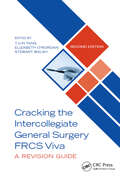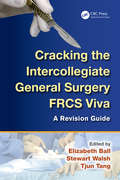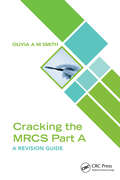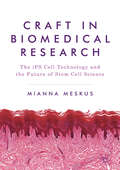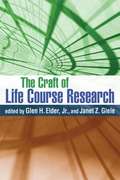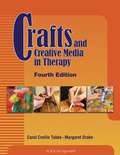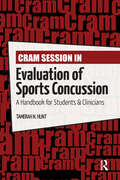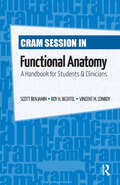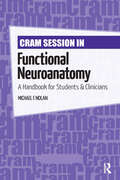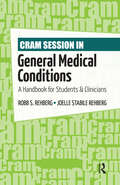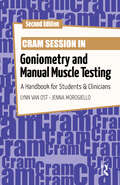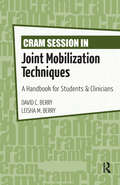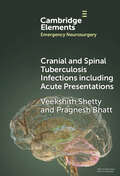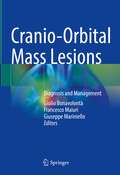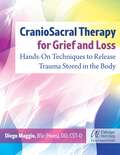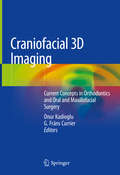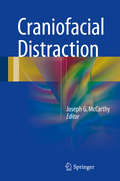- Table View
- List View
Cracking The MCAT, 2013-2014 Edition
by Princeton ReviewIf you need to know it for the MCAT, it's in this book. The MCAT is a challenging exam that tests more than your knowledge of basic physical and biological sciences. You need to know absolutely everything, from amino acids and proteins to translational motion to verbal reasoning, and more. Cracking the MCAT, 2013-2014 Edition will help you review all the necessary content with in-depth coverage of all subjects tested on the MCAT. This book includes: - Exclusive free online access to 4 full-length practice tests with comprehensive answers and explanations - A full-color, 16-page tear-out reference guide with all the most important formulas, diagrams, information, concepts, and charts for each section of the MCAT - Complete coverage of all the topics on the MCAT, including physics, general chemistry, biology, organic chemistry, and verbal reasoning - Practice passages, questions, and detailed explanation with step-by-step solutions at the end of every chapter for maximum practice and preparation - A bonus chapter containing helpful advice on effective study habits, applying to medical school, and top trends in health care - A comprehensive index Study your way to success with Cracking the MCAT, 2013-2014 Edition!
Cracking the General Surgical Interviews for ST3
by Sala Abdalla Amber Shivarajan Kaushiki SinghST3 interviews are extremely competitive and achieving the highest possible score is essential in securing the surgical training post of choice. The key to success in these interviews is through diligent preparation. This book outlines the structure and format of the ST3 general surgical interviews, with chapters dedicated to each component area that is assessed on the day. Written in an engaging style, it provides an essential resource for the interviews, with all of the required material in one book,a bonus for many readers with time constraints imposed by a demanding work schedule. It is aimed at instilling prospective surgeons with the tools and confidence needed to succeed at the ST3 general surgical interview. Success in these structured interviews will lead to the award of a ‘national training number’.
Cracking the Intercollegiate General Surgery FRCS Viva 2e: A Revision Guide
by Tjun Tang; Elizabeth O’Riordan; Stewart WalshCracking the Intercollegiate General Surgery FRCS Viva: A Revision Guide 2e provides the framework and knowledge to pass the non-subspecialty sections of the FRCS (General Surgery) viva and clinical examination. This comprehensive and up to date revision text covers all essential topics in critical care, emergency and general surgery as well as research papers, basic statistics and data manipulation for the academic section.This essential revision guide provides you with the vital points for each topic, presented in a concise, structured manner and referenced where appropriate. It is essential reading for anyone preparing for the FRCS General Surgery exam.
Cracking the Intercollegiate General Surgery FRCS Viva: A Revision Guide
by Elizabeth Ball Stewart Walsh Tjun TangThe FRCS examination is the last hurdle on the road to independent practice as a consultant surgeon in the United Kingdom and Ireland. The voce viva portion of the exam can be particularly challenging for candidates who must demonstrate not only their knowledge of various surgical topics, but also their reasoning and decision-making abilities.Crack
Cracking the MRCS Part A: A Revision Guide
by Olivia A SmithA unique revision guide aimed at candidates preparing for the MRCS examinations. The Part A exam tests knowledge of both basic science and the principles of surgery in general, and this textbook contains all the essential facts in one easy-to-read volume.There is a focus on the most common questions asked pertaining to anatomy (representing 42% of the MRCS Part A paper 1) as well as other common areas frequently asked about in both the Part A and B examinations, although the focus of this book is the Part A examination. The Anatomy coverage includes line diagrams, short easy-to-recall text and bullet point lists to ensure that revision time is maximised for exam success. High-yield content in the areas of Physiology, Pathology, Pharmacology and Mathematics is also included.The content has been designed specifically to help junior doctors memorise essential surgical facts,and further provides a convenient aide-memoire that will save hours of note taking.This will be particularly useful in the pressured run up to the MRCS examination.
Craft in Biomedical Research: The iPS Cell Technology and the Future of Stem Cell Science
by Mianna MeskusThis book explores the new ways in which biology is becoming technology. The revolutionary iPS cell technology has made it possible to turn human skin and blood cells into pluripotent stem cells, thus providing an unprecedented opportunity to study the pathophysiology of diseases, understand human developmental biology, and generate new therapies. Drawing from a rich ethnographic study, Meskus traces the making of the iPS cell technology through the perspectives of clinical translation, laboratory experimentation, and tissue donation by voluntary patients. Discussing non-human agency, the embodied and affective basis of knowledge production, and the material politics of science, the book develops the idea of an instrumentality-care continuum as a fundamental dynamic of biomedical craft. This continuum, Meskus argues, opens up a novel perspective to the commercialization and industrial-scale appropriation of human biology, and thereby to the future of ethical biomedical research.
Craft of Life Course Research
by Janet Giele Glen Elder Jr.This book brings together prominent investigators to provide a comprehensive guide to doing life course research, including an 'inside view' of how they designed and carried out influential longitudinal studies. Using vivid examples, the contributors trace the connections between early and later experience and reveal how researchers and graduate students can discover these links in their own research. Well-organized chapters describe the best and newest ways to Use surveys, life records, ethnography, and data archives to collect different types of data over years or even decades. Apply innovative statistical methods to measure dynamic processes that result in improvement, decline, or reversibility in economic fortune, stress, health, and criminality. Explore the micro- and macro-level explanatory factors that shape individual trajectories, including genetic and environmental interactions, personal life history, interpersonal ties, and sociocultural institutions.
Crafts And Creative Media In Therapy
by Carol Crellin Tubbs Margaret DrakeEngagement in crafts and other creative activities is making a comeback as an established method in the occupational therapy rehabilitation process. With the profession promoting a return to purposeful activity and “occupation” as key components of treatment, the Fourth Edition of Crafts and Creative Media in Therapy will continue to be a leading resource.
Crafts and Creative Media in Therapy
by Margaret Drake Carol TubbsFor more than 20 years, Crafts and Creative Media in Therapy, Fifth Edition has been an illuminating reference for the use of creative approaches in helping clients achieve their therapeutic goals. Carol Crellin Tubbs has included a range of craft and creative activity categories, from paper crafts, to cooking, to the use of recycled materials, and everything in between.Each chapter includes a brief history of the craft, several projects along with suggestions for grading or adapting, examples of related documentation, and a short case study. The text also features chapters on activity analysis, general strategies for implementation of creative activities, and documentation, as well as a chapter describing the relevance of this media from both historical and current occupation-based perspectives.In this updated Fifth Edition, the craft projects have been updated and numerous resources and links for more ideas have been added. There are new chapters on making therapy tools and crafting with a purpose, and the recycled and found materials chapter has been expanded in keeping with cultural trends. A flow chart has been added to each case study to help students better understand the process and rationale for tailoring activities for individual client needs, and project suggestions for working on specific performance skills or client factors are scattered throughout the chapters. Other additions include a behavioral observation checklist as an aid in evaluation and documentation, and several illustrations to help students distinguish between the use of occupation as means and occupation as end. This Fifth Edition also includes an updated instructors’ manual with additional resources and suggestions for lesson planning.Crafts and Creative Media in Therapy, Fifth Edition not only provides a wide assortment of craft ideas and instructions, but also provides multiple suggestions for therapeutic uses for activities in each category. It includes ways to grade activities to best achieve therapy objectives, and examples of documentation for reimbursement. For each craft category, there is discussion on precautions for use with certain populations, contextual limitations, and safety considerations. Information is presented in several different formats such as examples, tables, illustrations, and other formats to promote student understanding.Included with the text are online supplemental materials for faculty use in the classroom. .Crafts and Creative Media in Therapy, Fifth Edition is the foremost resource for using creative approaches in helping clients achieve their therapeutic goals and should be used by all occupational therapists, occupational therapy assistants, and recreational therapists.
Cram Session in Evaluation of Sports Concussion: A Handbook for Students & Clinicians
by Tamerah HuntWhen you need a fundamental and clinical understanding of sports concussions, supplemented by current research and management techniques, look to Cram Session in Evaluation of Sports Concussion: A Handbook for Students & Clinicians for quick and at-your-fingertips facts.Cram Session in Evaluation of Sports Concussion: A Handbook for Students & Clinicians by Dr. Tamerah N. Hunt is a succinct and descriptive quick reference that provides the health care professional with a simple step-by-step approach to various sports concussion assessment and management techniques. Cram Session in Evaluation of Sports Concussion: A Handbook for Students & Clinicians is designed to bridge the gap between research and clinical practice to improve assessment and management of sports-related concussion and return-to-play decisions. What is in your “Cram Session”: • Concept maps• Red flags for differential diagnoses• Return to participation guidelines• Detailed algorithms for evaluation, testing, and working with other health care professionals• Model protocols and management strategies that can be implemented with minimal resources and support staffCram Session in Evaluation of Sports Concussion: A Handbook for Students & Clinicians is an informative, well-organized handbook for all students and clinicians in athletic training, physical therapy, and allied health professionals who evaluate and manage concussions.
Cram Session in Functional Anatomy: A Handbook for Students and Clinicians
by Scott Benjamin Roy Bechtel Vincent ConroyWhen all you need is a basic understanding of the anatomy of the muscular system, supplemented by current evidence and research, Cram Sessions on Functional Anatomy: Applications and Problem Solving for Real-Life Situations is what you will look to for quick, at-your-fingertips facts.Cram Sessions on Functional Anatomy by Drs. Benjamin, Bechtel, and Conroy is a concise and illustrated quick reference that takes over 60 years of combined clinical experience to provide an understanding of the muscular system and its relation to the fascial and ligamentous systems in the human body, providing benefits for improved patient care and streamlined exercise prescription.What is in your Cram Session? Translation of basic anatomy through both clinical expertise and research evidence A unique understanding of the muscular system and its role in health and disease A section on “clinical pearls” for each muscle or group – helping make practical use of the anatomical data, and improving the diagnosis and treatment of common patient problems Over 100 photographs and line art depicting each muscle or group of muscles Cram Sessions on Functional Anatomy: Applications and Problem Solving for Real-Life Situations is a practical, easy-to-read handbook for all students and clinicians involved in physical therapy, athletic training, occupational therapy, and other rehabilitation professions.
Cram Session in Functional Neuroanatomy: A Handbook for Students & Clinicians
by Michael NolanWhen all you need is a basic understanding of the human nervous system, look to Cram Session in Functional Neuroanatomy: A Handbook for Students & Clinicians.This handbook gives you basic information in a readily accessible format, as well as more detailed concepts that will allow you to better understand not only how the human nervous system works, but how injuries and disease affect experience and behavior, including cognitive and intellectual functions.Cram Session in Functional Neuroanatomy: A Handbook for Students & Clinicians by Dr. Michael F. Nolan is a concise and illustrated quick reference that highlights important anatomical and physiological principles of the nervous system. These key points will enhance understanding of the nervous system and how specific populations of nerve cells and neural systems influence human experience and behavior.WHAT IS IN YOUR CRAM SESSION?• Concise and focused explanations of topics specifically related to neuroanatomy • Topic self-assessment questions formatted as short answer exercises, ideal for exam review and preparation• List of laboratory structures – an excellent tool to aid faculty with additional methods of learning• More than 75 photographs and illustrations Included with the text are online supplemental materials for faculty use in the classroom.Cram Session in Functional Neuroanatomy: A Handbook for Students & Clinicians is a perfect text for physical therapy students and other medical and health professionals in neurology and neurosurgery.
Cram Session in General Medical Conditions: A Handbook for Students and Clinicians
by Robb Rehberg Joelle RehbergAre you a rehabilitation professional or student in need of a basic understanding of general medical conditions? Supplemented by concise and user-friendly clinical information on the conditions, Cram Session in General Medical Conditions: A Handbook for Students & Clinicians is the perfect resource for quick and “at your fingertips” facts.Cram Session in General Medical Conditions: A Handbook for Students & Clinicians by Dr. Robb S. Rehberg and Dr. Joelle Stabile Rehberg is a succinct and descriptive quick reference that provides the rehabilitation professional with a very basic approach to understanding various general medical conditions. What is in your “Cram Session”:• Breakdown of each medical condition covered• Each condition includes the name of the condition, alternate names, description, causes, clinical presentation, symptoms, diagnosis, and management• Includes over 125 general medical conditions in over 13 categoriesCram Session in General Medical Conditions: A Handbook for Students & Clinicians is an informative, well-organized handbook for all students and clinicians in athletic training, physical therapy, occupational therapy, and orthopedics.
Cram Session in Goniometry and Manual Muscle Testing: A Handbook for Students and Clinicians
by Lynn Van Ost Jenna MorogielloNewly updated, Cram Session in Goniometry and Manual Muscle Testing: A Handbook for Students & Clinicians, Second Edition, is a descriptive quick reference guide for rehabilitation professionals organized in a “head-to-toe” format, including more than 400 photographs and supplemented with concise and illustrative examples of various techniques.The new edition of this text maintains the original essence of the first edition while touching upon updated information to speak to new clinicians. Minor revisions, such as adding color to the headers and to the sections, allow the reader easier access to the topics. An expanded appendix and up-to-date content touch on newer technology being used and developed in these areas of clinical evaluation.What is in your Cram Session: In the Goniometry section, subdivisions are broken down into type of joint, capsular pattern, average range of motion for each movement, patient positioning, goniometric alignment, patient substitutions, and alternative methods of measurement. In the Manual Muscle Testing section, subdivisions are broken into the specific movement to be tested, average range of motion, prime movers of the movement, secondary movers of the movement, anti-gravity patient position, gravity minimized patient position, stabilization and grades, substitutions for the movement, and points of interest for that particular muscle group. Cram Session in Goniometry and Manual Muscle Testing: A Handbook for Students & Clinicians, Second Edition, is an informative, well-organized handbook for all students, instructors, and clinicians in physical therapy, occupational therapy, athletic training, orthopedics, or any allied health professional who treats musculoskeletal disorders.
Cram Session in Goniometry: A Handbook for Students and Clinicians
by Lynn Van OstWhen all you need is a basic understanding of goniometry. When concise and illustrative examples of goniometric techniques will provide exactly what the rehabilitation professional needs—Look to Cram Session in Goniometry: A Handbook for Students and Clinicians for quick and “at your fingertips” facts.Cram Session in Goniometry by Lynn Van Ost is a concise and abundantly illustrated quick reference which provides the rehabilitation professional with a very basic approach to various goniometric techniques. Organized in a “head to toe” format, Cram Session in Goniometry takes user-friendly and efficient learning to a new level.What is in your “Cram Session”:• Photographs depicting each goniometric measurement• Breakdown of each body region covered• Each type of joint, capsular pattern, average range of motion, patient positioning, goniometric alignment, patient substitutions, and alternative methods of measurement• Over 190 photographsCram Session in Goniometry: A Handbook for Students and Clinicians is an informative, well-organized handbook for all students and clinicians in physical therapy, occupational therapy, athletic training and orthopedics.
Cram Session in Joint Mobilization Techniques: A Handbook for Students & Clinicians
by David Berry Leisha BerryWhen all you need is a basic understanding of joint mobilization techniques, supplemented by succinct and demonstrative examples, look to Cram Session in Joint Mobilization Techniques: A Handbook for Students & Clinicians for quick, at-your-fingertips facts.Cram Session in Joint Mobilization Techniques by Dr. David C. Berry and Leisha M. Berry is a descriptive quick reference that provides the rehabilitation professional with a detailed yet easy-to-digest approach to joint mobilization techniques. Organized into quick-reference tables and concise descriptions of each technique, this resource offers an efficient way to learn the cognitive and psychomotor skills necessary to competently perform joint mobilization techniques.What is in your Cram Session: Easy-reference tables of joint complex osteology and arthrology Photographs depicting mobilization techniques for each joint Case studies in mobilization Quiz questions to test your knowledge Cram Session in Joint Mobilization Techniques: A Handbook for Students & Clinicians is an informative, well-organized handbook for all students and clinicians in athletic training, physical therapy, occupational therapy, osteopathic medicine, and other rehabilitation professions.
Cram Session in Manual Muscle Testing: A Handbook for Students and Clinicians
by Lynn Van OstWhen all you need is a basic understanding of manual muscle testing. When concise and illustrative examples of manual muscle testing techniques will provide exactly what the rehabilitation professional needs, look to Cram Session in Manual Muscle Testing: A Handbook for Students & Clinicians for quick and “at your fingertips” facts.Cram Session in Manual Muscle Testing: A Handbook for Students & Clinicians by Lynn Van Ost is a succinct and descriptive quick reference that provides the rehabilitation professional with a very basic approach to various manual muscle techniques. Organized in a “head to toe” format, Cram Session in Manual Muscle Testing: A Handbook for Students & Clinicians takes user-friendly and efficient learning to a new level.What is in your “Cram Session”:• Photographs depicting each manual muscle testing technique• Breakdown of each body region covered• Sections include average range of motion, prime movers, accessory muscles, patient positioning, muscle grading for each movement and substitutions• Over 200 photographsCram Session in Manual Muscle Testing: A Handbook for Students & Clinicians is an informative, well-organized handbook for all students and clinicians in physical therapy, occupational therapy, athletic training, orthopedics or any allied health professional who treats musculoskeletal disorders
Cranial Nerves: Functional Anatomy
by Stanley MonkhouseCranial nerves are involved in head and neck function, and processes such as eating, speech and facial expression. This clinically oriented survey of cranial nerve anatomy and function was written for students of medicine, dentistry and speech therapy, but will also be useful for postgraduate physicians and GPs, and specialists in head and neck healthcare (surgeons, dentists, speech therapists etc. ). After an introductory section surveying cranial nerve organisation and tricky basics such as ganglia, nuclei and brain stem pathways, the nerves are considered in functional groups: (1) for chewing and facial sensation; (2) for pharynx and larynx, swallowing and phonation; (3) autonomic components, taste and smell; (4) vision and eye movements; and (5) hearing and balance. In each chapter, the main anatomical features of each nerve are followed by clinical aspects and details of clinical testing. Simple line diagrams accompany the text. Detailed anatomy is not given.
Cranial Osteomyelitis: Diagnosis and Treatment
by Ali AkhaddarThis book is the first reference book covering exclusively all aspects of this challenging disease. It is designed to serve as a succinct appropriate resource for neurosurgeons, otorhinolaryngologists, neuroradiologists, researchers and infectious disease specialists with an interest in cranial infection. Cranial Osteomyelitis provides an in-depth review of knowledge of the management of skull osteomyelitis, with an emphasis on risk factors, causative pathogens, pathophysiology of dissemination, clinical presentations, neuroradiological findings and treatment modalities, medical and surgical. Sections on the prognosis and prevention of this illness are also included. The book will help the reader in choosing the most appropriate way to manage this challenging bone infection. In addition, it supplies clinicians and investigators with both basic and more sophisticated information and procedures relating to the complications associated with skull osteomyelitis. It also considers future areas of investigation and innovative therapeutic philosophies. The book is richly illustrated to provide readers with unparalleled access to a comprehensive collection of cranial osteomyelitis images (biological, clinical, neuroradiological, and surgical) taken directly from the author's collection and experience in the field.
Cranial and Spinal Tuberculosis Infections including Acute Presentations (Elements in Emergency Neurosurgery)
by Veekshith Shetty Pragnesh BhattCentral nervous system, affliction, although rare, represents one of the most severe extra-pulmonary manifestations of tuberculosis, potentially leading to substantial morbidity and mortality if not promptly addressed. Cranial tuberculosis can manifest in various forms, including tuberculomas, encephalitis, abscesses, and meningitis, with the latter being the most critical and carrying a poor prognosis if left untreated. Spinal tuberculosis, accounting for approximately 50% of musculoskeletal TB cases, can present with a spectrum of symptoms, ranging from simple back pain to more severe neurological deficits such as weakness and deformity. Anti-tuberculosis medications remain the cornerstone of treatment, and this Element offers an algorithmic approach to managing referrals of suspected tuberculosis, incorporating pertinent clinical information to facilitate effective decision-making.
Cranio-Orbital Mass Lesions: Diagnosis and Management
by Giulio Bonavolontà Francesco Maiuri Giuseppe MarinielloThis book fills a gap in the field of the cranio-orbital lesions, as it deals only with mass lesions involving both the intracranial and intra-orbital compartments. The surgical anatomy, diagnosis, surgical approaches and specified pathological mass lesions are described in detalis.The book includes four parts. Part 1, is devoted to the surgical anatomy of the orbital region. Part 2 to the clinical and neuroradiological examination of the cranio-orbital mass lesions. Part 3 discusses the surgical approaches, both trans-cranial and transorbital, and microscopic and endoscopic, focusing on the surgical techniques, their indications, advantages, limitations and complications. Finally, part 4 discusses the single pathological mass lesions, their anatomo-clinical and radiological aspects and the best surgical approaches. Aim of this book is to illustrate the best surgical approaches according to prevalent intracranial or intra-orbital extension and the type of the mass lesions.
Cranio-Sacral Integration: Foundation
by Sam Wilson Thomas Attlee R.C.S.T.This foundation volume presents a unique integration of the wide spectrum of approaches to Cranio-Sacral Therapy, providing practitioners and students with a broad and authoritative understanding of the discipline. The author covers the fundamentals of theory as well as the practical skills and techniques needed to carry out Cranio-Sacral work, and the book also includes detailed instructions for treatments, all of which are clearly explained in extensive case histories, photographs and illustrations. Based upon the syllabus of the College of Cranio-Sacral Therapy in London, UK, this is an unparalleled resource for practitioners of Cranio-Sacral Therapy and Cranial Osteopathy, and an essential reference for students.
CranioSacral Therapy for Grief and Loss: Hands-On Techniques to Release Trauma Stored in the Body
by Diego Maggio• Explains how CranioSacral Therapy and SomatoEmotional Release can help you through the common traumas of the life cycle, from birth to death• Shares techniques and exercises to help process emotions and experiences, assess the functionality of the body&’s systems and energetic framework, and recognize and transform destructive energies into constructive processes• Looks at how to enhance CST techniques with other protocols, including the Holmes and Rahe Stress Scale and Elisabeth Kübler-Ross&’ stages of griefLoss, abandonment, separation, and grief—many of life&’s most challenging experiences—are also the most common. But the trauma created by these experiences does not need to hold us back in life. As Diego Maggio shows, we can use the techniques of CranioSacral Therapy (CST) and SomatoEmotional Release (SER) to understand, address, and overcome the stress that traumatic events cause and transform the painful experiences inherent in life into opportunities for growth and expanded awareness.Sharing Dr. Upledger&’s techniques and his own innovative applications of CST and SER across 20 years of practice, Maggio presents tools and exercises to facilitate your inner self-healing mechanisms and support yourself and others through the stages of grief and bereavement following a loss—whether the loss is large or one of the &“small deaths,&” such as losing a job or ending a relationship. The author explores all of the biological and energetic evolutionary stages of the life cycle through the lens of CST and shares manual therapy techniques and self-help exercises to process emotions and experiences, assess the energetic framework of the body and the chakras, and recognize and transform destructive energies into constructive processes. He looks at how to combine CST techniques with other protocols for managing the grieving process, including the Holmes and Rahe Stress Scale and Elisabeth Kübler-Ross&’s stages of grief. He also explores how CST and SER techniques can help support the dying and those around them in the process of transition.Revealing how CranioSacral Therapy can help us integrate challenges and traumas whether recent or long past, Maggio shows how our experiences can give us the opportunity to evolve and grow as we journey through the beautiful cycles of life.
Craniofacial 3D Imaging: Current Concepts In Orthodontics And Oral And Maxillofacial Surgery
by Onur Kadioglu G. Fräns CurrierThis book is designed to serve as an up-to-date reference on the use of cone-beam computed tomography for the purpose of 3D imaging of the craniofacial complex. The focus is in particular on the ways in which craniofacial 3D imaging changes how we think about conventional diagnosis and treatment planning and on its clinical applications within orthodontics and oral and maxillofacial surgery. Emphasis is placed on the value of 3D imaging in visualizing the limits of the alveolar bone, the airways, and the temporomandibular joints and the consequences for treatment planning and execution. The book will equip readers with the knowledge required in order to apply and interpret 3D imaging to the benefit of patients. All of the authors have been carefully selected on the basis of their expertise in the field. In describing current thinking on the merits of 3D craniofacial imaging, they draw both on the available scientific literature and on their own translational research findings.
Craniofacial Distraction
by Joseph G. MccarthyDr. McCarthy and his colleagues at NYU have developed techniques of distracting various components of the craniofacial skeleton. These techniques hold considerable promise for reconstructive surgery, allowing the surgeon to make precise changes in the lengthening and shape of the new craniofacial bone. This is the first volume of its kind, bringing together the pioneers of these revolutionary techniques: an international group of experts present their clinical and laboratory experience with distraction of the cranial vault, orbit, midface and zygoma, and mandible, as well as the principles of distraction, biomechanics, and the physiology of bone healing and remodelling. With two hundred illustrations, this is a must for all reconstructive plastic, maxillofacial, and oral surgeons.
